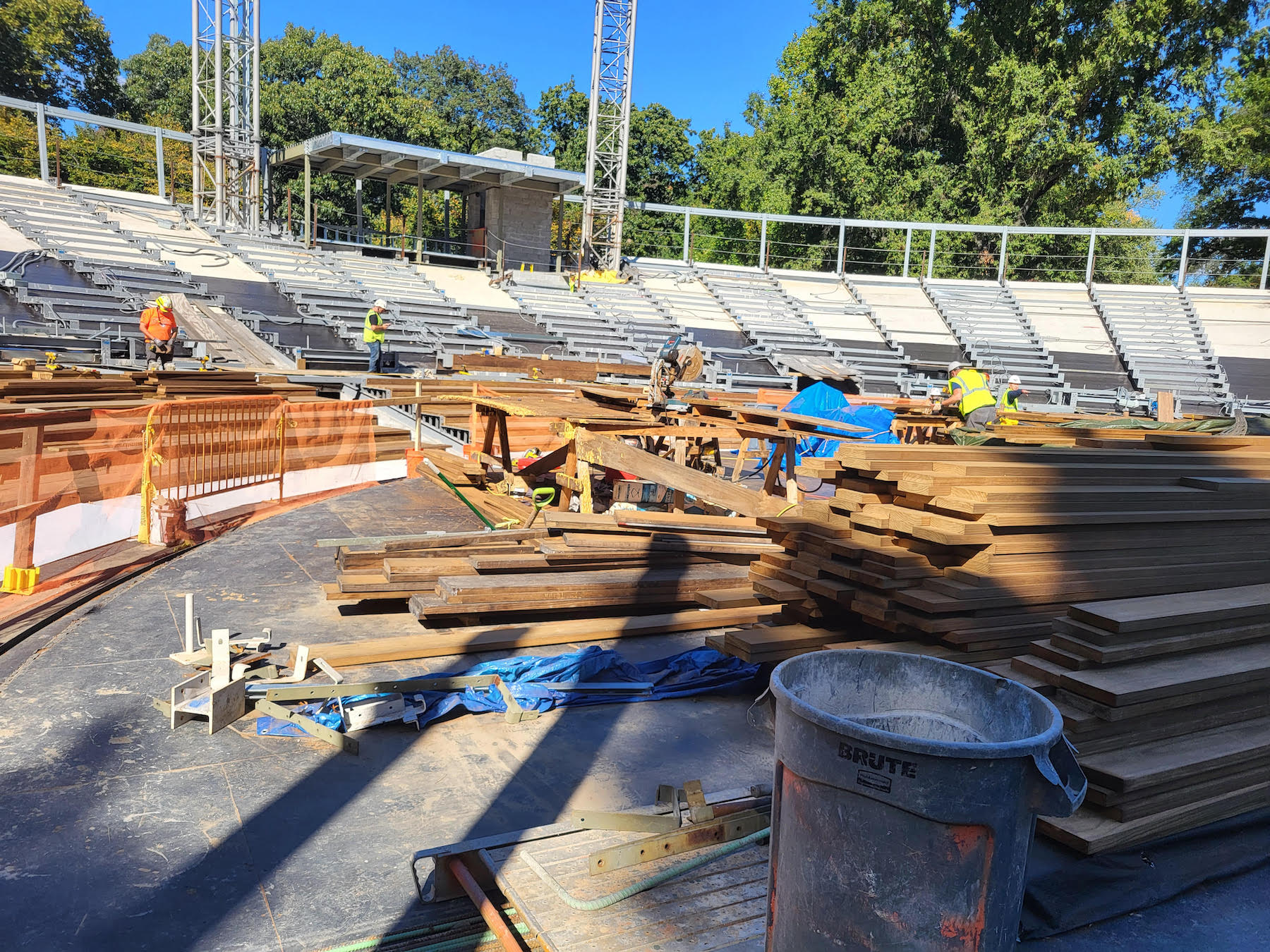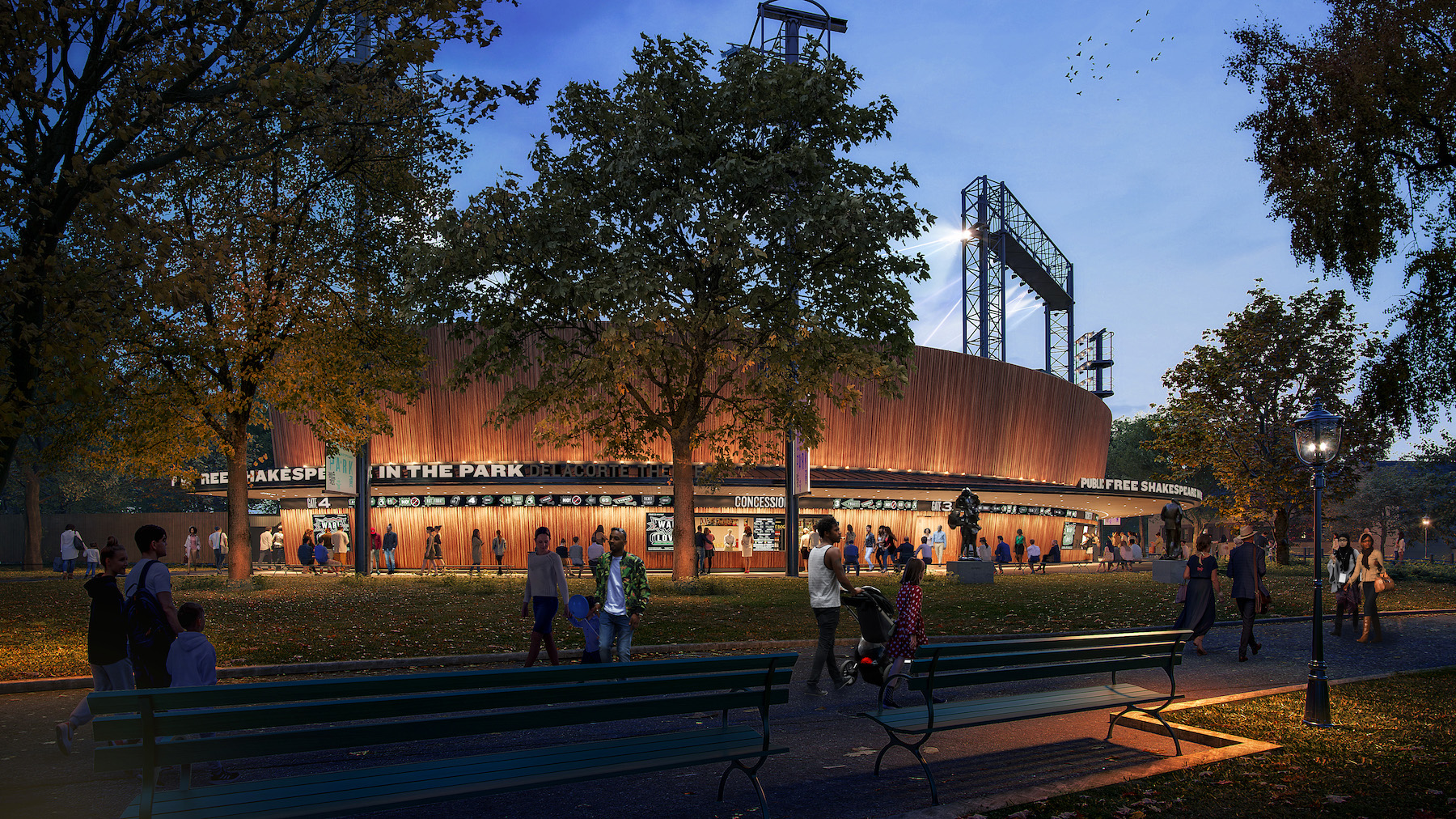The open-air Delacorte Theater in New York City’s Central Park, which since 1962 has been presenting free Shakespeare in the Park and other classical plays, has been undergoing a complete renovation—its first major capital improvement since 1999—that is upgrading the entire complex, with a concentration on accessibility, aesthetics, comfort, and water mitigation.
The Public Theater, Delacorte’s operator and programmer, is executing this 18-month $78 million renovation, which began a year ago, in partnership with the Central Park Conservancy and the New York City Parks Department. It’s scheduled for completion next summer, and its first post-reno production will be Shakespeare’s Twelfth Night.
Last week, BD+C toured the jobsite with representatives of The Public Theater and Ennead Architects, the project’s design architect. They recounted how plans for this renovation had been in the works since 2018. Getting those plans to the construction phase required approvals from five community boards and the city’s Landmark Preservation Commission. The Mayor’s Office ultimately kicked in $41 million toward the project’s renovation costs.
A ‘brownstone’-like renovation
The project’s mission is to enhance what was there
already. Virtually everything but the theater’s exterior steel framing was stripped away, and is being replaced, upgraded and, in some cases, expanded. The construction includes a secondary steel structure that tilts out so that an extra seating row could be added within the theater for patrons with accessibility needs. That steel structure will be covered with a redwood façade, salvaged from decommissioned water towers and supplied by Brooklyn-based Tri-Lox, with each tongue-and-groove piece installed individually.

A lot of attention has been paid to improving and streamlining the backstage working environment for the actors and crew. HVAC and water systems are being expanded and brought up to code. The understage area is steel reinforced and enlarged for better maneuverability. The five dressing rooms are being reframed and made more accessible; three of them will have gender-neutral bathrooms.
Apparently, the Delacorte leaked like a sieve when it rained, so the renovation has focused on minimizing water intrusion via the installation of insulation and corrugated steel beneath the grandstands and in the dressing rooms. The improvements include new sprinkler and fire alarm systems.
(A joint venture between Turner Construction and York Construction is this project’s GC. Silman Structural Solutions is the SE, and Loring Consulting Engineers is the MEP engineer.)
Reno part of a bigger campaign

The Delacorte seats 1,872, and that capacity isn’t changing. However, within the performance area, the the aisles have been reconfigured to be more accessible. (About 30 seats will be available specifically for handicapped patrons.) The wood decking within the seating area and the stage is being replaced with a more durable material supplied by Kebony North America. The control tower is being rebuilt to include an elevator. Newly designed lighting towers will provide improved illumination for the stage and performances, and will include safety features for crew members and increase efficiency for load-in and load-out of shows.
Audience and backstage ramps are being built on one side of the seating area.
The Public Theater will have offices onsite at the Delacorte, whose renovation is a component of the Public’s $150 million capital campaign that also will support the organization’s other free theater initiatives, including The Mobile Unit and Public Works; the recently renovated Public Studios at 440 Lafayette Street; and capital upgrades to The Public’s headquarters at 425 Lafayette Street. The campaign includes The Fund for Free Theater, which supports the Public’s Shakespeare in the Park productions.
Related Stories
| Aug 11, 2010
Restoration gives new life to New Formalism icon
The $30 million upgrade, restoration, and expansion of the Mark Taper Forum in Los Angeles was completed by the team of Rios Clementi Hale Studios (architect), Harley Ellis Devereaux (executive architect/MEP), KPFF (structural engineer), and Taisei Construction (GC). Work on the Welton Becket-designed 1967 complex included an overhaul of the auditorium, lighting, and acoustics.
| Aug 11, 2010
Gold Award: Eisenhower Theater, Washington, D.C.
The Eisenhower Theater in the John F. Kennedy Center for the Performing Arts in Washington, D.C., opened in 1971. By the turn of the century, after three-plus decades of heavy use, the 1,142-seat box-within-a-box playhouse on the Potomac was starting to show its age. Poor lighting and tired, worn finishes created a gloomy atmosphere.
| Aug 11, 2010
Giants 300 University Report
University construction spending is 13% higher than a year ago—mostly for residence halls and infrastructure on public campuses—and is expected to slip less than 5% over the next two years. However, the value of starts dropped about 10% in recent months and will not return to the 2007–08 peak for about two years.
| Aug 11, 2010
Bowing to Tradition
As the home to Harvard's Hasty Pudding Theatricals—the oldest theatrical company in the nation—12 Holyoke Street had its share of opening nights. In April 2002, however, the Faculty of Arts and Sciences decided the 1888 Georgian Revival building no longer met the needs of the company and hired Boston-based architect Leers Weinzapfel Associates to design a more contemporary facility.
| Aug 11, 2010
Team Tames Impossible Site
Rensselaer Polytechnic Institute, the nation's oldest technology university, has long prided itself on its state-of-the-art design and engineering curriculum. Several years ago, to call attention to its equally estimable media and performing arts programs, RPI commissioned British architect Sir Nicholas Grimshaw to design the Curtis R.
| Aug 11, 2010
Silver Award: Hanna Theatre, Cleveland, Ohio
Between February 1921 and November 1922 five theaters opened along a short stretch of Euclid Avenue in downtown Cleveland, all of them presenting silent movies, legitimate theater, and vaudeville. During the Great Depression, several of the theaters in the unofficial “Playhouse Square” converted to movie theaters, but they all fell into a death spiral after World War II.
| Aug 11, 2010
Biograph Theater
Located in Chicago's Lincoln Park neighborhood, Victory Gardens Theater Company has welcomed up-and-coming playwrights for 33 years. In 2004, the company expanded its campus with the purchase of the Biograph Theater for its new main stage. Built in 1914, the theater was one of the city's oldest remaining neighborhood movie houses, and it was part of Chicago's gangster lore: in 1934, John Dillin...
| Aug 11, 2010
Platinum Award: Reviving Oakland's Uptown Showstopper
The story of the Fox Oakland Theater is like that of so many movie palaces of the early 20th century. Built in 1928 based on a Middle Eastern-influenced design by architect Charles Peter Weeks and engineer William Peyton Day, the 3,400-seat cinema flourished until the mid-1960s, when the trend toward smaller multiplex theaters took its toll on the Fox Oakland.







